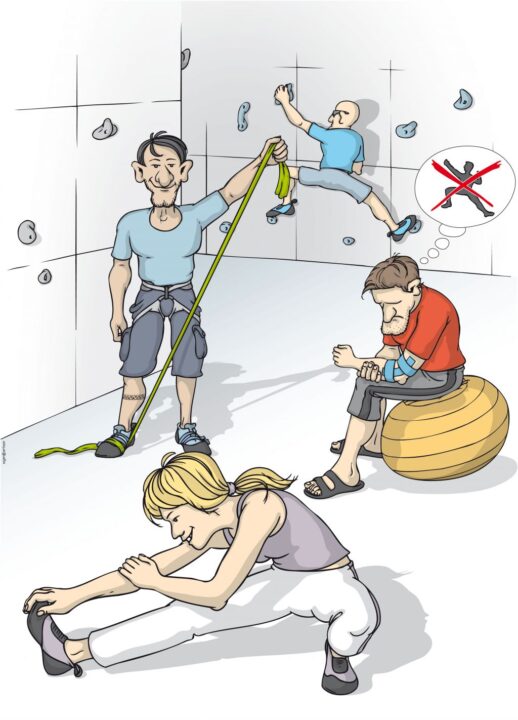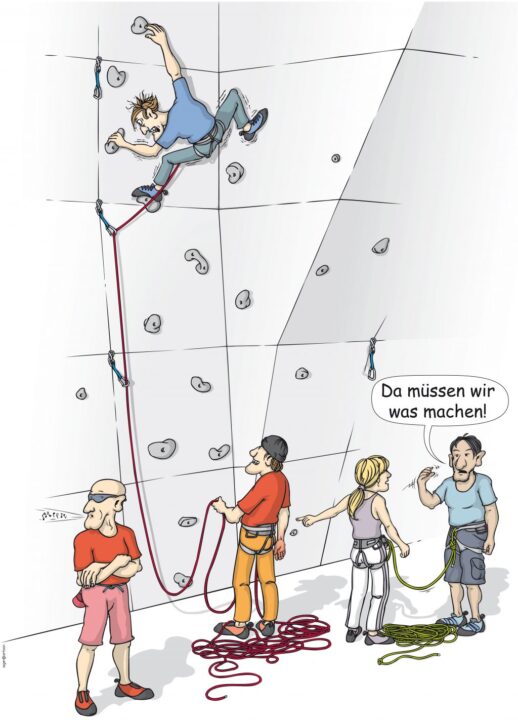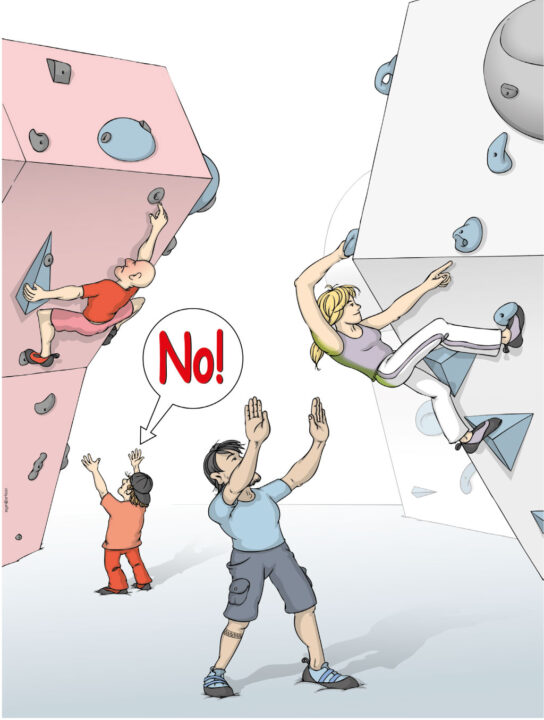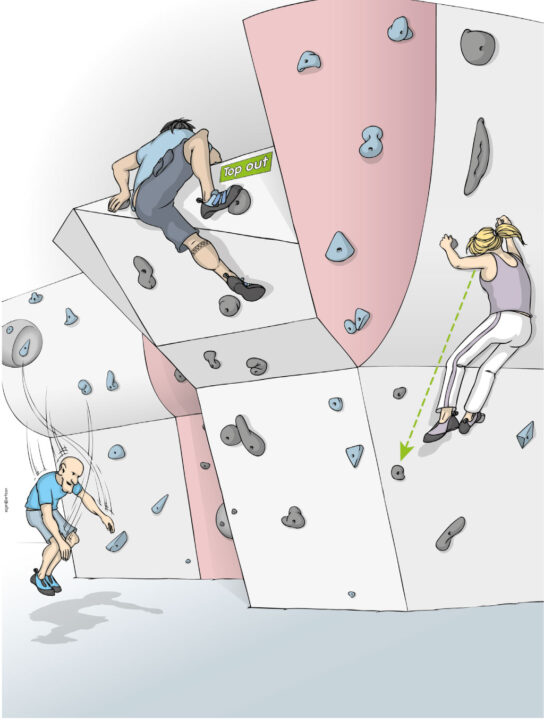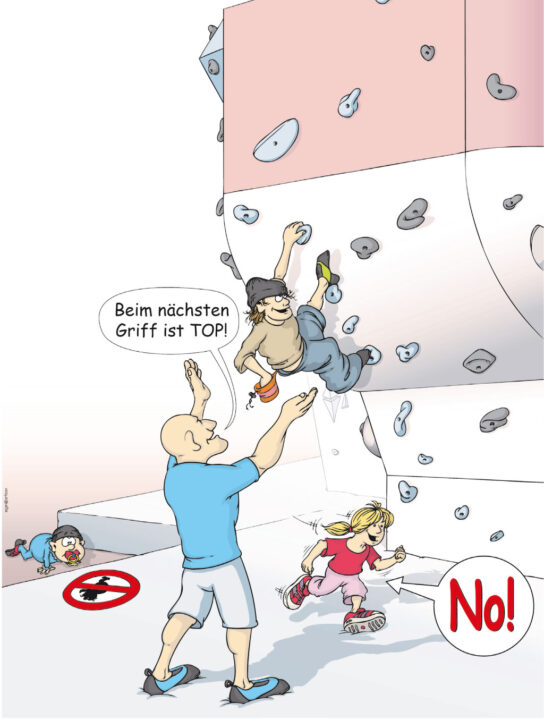Safety
Climbing is a high-risk sport and can result in serious, sometimes fatal injuries. As your safety is very important to us, we would like to draw your attention to some general safety factors that must be taken into account in the sports facility, but especially when rope climbing and bouldering. Please read these safety instructions and the house rules carefully and have the courage to draw the attention of others to potential dangers or risks. You are not only protecting the lives of others, but ultimately yourself also. Thank you very much.
Safety in the
Kletterhalle
- Personal responsibility: Climbing is at your own risk. With your registration and signature, you confirm that you have all the knowledge and experience required for visiting a climbing facility, for practicing rope climbing and bouldering, and that you are competently trained. The operator of the climbing facility does not carry out any checks on the safety skills of visitors. When you purchase a ticket, you are automatically obliged to comply with our house rules and to accept the general terms and conditions.
- Cleanliness, tidiness and behaviour: A certain degree of cleanliness, tidiness and good behaviour contributes significantly to safety in climbing gyms. Please use the changing room lockers, storage compartments and shelves to store your backpacks and bags and do not leave them lying around on the ground or in the fall area of climbers. This will help you to avoid unnecessary injuries. Keep escape routes and emergency exits free in the event of a fire. Avoid unnecessary noise and be considerate of other visitors.
- Minors and beginners: Minors may only use the climbing facility under the constant supervision of an adult and competent companion. Excluded are young people from 14 to 18 years who can show a declaration of consent from a legal guardian, or 12-13 year old squad athletes with the signature of a parent and the club trainer (see New Here - Registration and first steps). Beginners should attend a climbing course, be trained and never use the climbing hall without expert, adult supervision.
- Playing and running around prohibited: With the exception of the children's paradise and cordoned off areas in the training course gallery, playing and running around is prohibited throughout the climbing facility. The danger of getting into the fall area of other climbers or impeding belayers is far too great. Parents and guardians are responsible for their children.
- Avoid fall zones: As soon as you enter the climbing hall or bouldering hall, you should be careful to avoid the fall area of other climbers! Never stand below people who are climbing, they or other objects could fall on you, e.g. broken holds, mobile phones, keys, belay devices, etc. The bouldering mats are primarily used to prevent falls and should not be used for sitting around as there is a risk of injury! We ask you to sit only at the edge of the mats. It is essential to conduct any gymnastics or warm-up exercises in non-hazardous areas, e.g. the gymnastics zone on the upper floor. The barriers set up during route setting must be observed.
- Mobile phone, music, jewellery, alcohol and many other logical things: Telephoning while belaying is distracting and is therefore forbidden. Listening to loud music with headphones also impairs attention and should be avoided. Rings, necklaces, other jewellery, as well as loose, long hair can get caught on quick-draws, bolts and holds causing serious injuries. Never climb after drinking alcohol. It is forbidden to bring animals into the climbing facility.
- First aid obligation: All users of the facility are obliged to provide assistance in the event of accidents and must provide their personal details if the accident is recorded by the police. We ask you to report accidents of all kinds to our staff immediately.
- Behaviour in the event of fire: In the event of a fire, the entire facility must be evacuated immediately via the emergency exits in the direction of the collection point at the outdoor climbing towers. Instructions from staff must be followed.
- Weights room: Training on the weight machines, especially with the free weights, dumbbells and bars, requires experience and can be very dangerous if not done correctly. Children under the age of 14 are not allowed to use the gym.
Rope Climbing
Safety
- Competency check: Before every climbing session, make sure the safety skills of your climbing partner are up to date. If necessary, check whether an unexpected fall can be dynamically arrested. Keep yourself up to date, be self-critical and open to feedback.
- Partner check: Before starting each route, do a mutual partner check and go over the following points: proper knot in the correct place, climbing harness fastened correctly, closed carabiner, belay device correctly set up using a blocking test, sufficient rope length and a stopper knot at the end of the rope.
- Operating belay devices: Read the instructions for your belay device carefully and avoid improper operation. Pay particular attention to the brake hand principle. Use equipment you are familiar with. We recommend semi-automatic devices as they provide additional security
- arm-up properly: Warming-up properly before climbing prevents injuries. Slowly increase the intensity of your exercises and try to climb out or stretch after the main part of your climbing session.
- Fall correctly: Learn the correct way to fall into a rope beforehand or on a practice wall. A posture that is ready to move, knees slightly bent and looking down are crucial for absorbing the impact properly. A passive attitude when falling can lead to serious injuries! Always make sure not to climb behind the rope due to the danger of being flipped upside down. You are welcome to attend one of our climbing courses for exactly this purpose.
- Belay properly: When belaying, be careful not to be distracted by other people. Belay glasses help to maintain attention. Avoid unnecessary slack rope and don’t stand too far from the climbing wall. Belaying while sitting and telephoning while belaying is strictly forbidden!
- Clip correctly: Always try to attach the rope to the carabiner from a stable position and avoid falling when clipping (danger of groundfall). Avoid a hyperextended body position when clipping and never put 2 ropes in a carabiner.
- Keep your distance: When climbing, make sure you keep a sufficient distance from other climbers and do not climb into the fall area of people climbing in front of you or to the side. A minimum distance of 5 quickdraws should be maintained and the adjacent routes must be kept free. Watch out for pendulum falls! Climbers falling on you can seriously injure you in the middle of the wall!
- Assess the risks: Adjust the difficulty and risk to your own ability and avoid unnecessary falls. Note the high risk of collision with other people in the case of pendulum falls. All intermediate quickdraws must be clipped!
- Keep the fall area/safety floor clear: Make sure that there are no hard objects or rucksacks lying around on the floor, either in the climber’s fall area or in the belayer’s movement area. You can trip over it when belaying and injure yourself unnecessarily. The advantages of the safety floor can only be utilized when there are no obstacles or hard objects in the way. Store your things on the shelves provided and place the drinking bottles right against the climbing wall where nobody can fall on them.
- Lower off slowly from the top of the route: Climbers should always contact belayers when they reach the top and not simply jump into the rope without communication. Belayers should ensure a slow and even descent and to a free landing spot.
- Top-rope safely: Top roping is only allowed on the special protection points at the end of routes. The two safety carabiners at the top of the route must be attached in opposite directions. When belaying, always check whether the correct strand of rope is attached to the belay device. Top-roping in severely overhanging routes may only be practised when intermediate protection has been clipped due to the danger of swinging. Top-roping from the middle of the climbing wall is not allowed! 🚫
- Safety with Auto-Belay: When climbing with automatic belay machines, the crucial partner check is skipped. Therefore, you must observe the following with automatic belay machines:
- Do a pull test before each start and pay attention to resistance and cable pull-in.
- Tie yourself in properly and check that the carabiner is closed.
- Make sure that your landing area or fall area is clear.
- Do not climb out of the climbing line or switch lines.
- Climb at the right pace. Do not continue climbing if the cable is slack.
- Note the maximum weight of 130 kg and the minimum weight of 15 kg.
- Report any damage, defects, strange noises or defects immediately to the staff.
- Safety in the outdoor area: Depending on the weather, there can be additional dangers in the outdoor area: wind, rain, lightning, moisture, ice, snow, etc. It is strongly recommended to avoid the outdoor area when storms, thunderstorms, snow or ice are approaching. Large temperature fluctuations can also loosen the climbing holds, so that they can rotate unexpectedly. Here increased caution is required when securing.
Safe rope climbing indoor
10 climbing rules of the Alpenverein
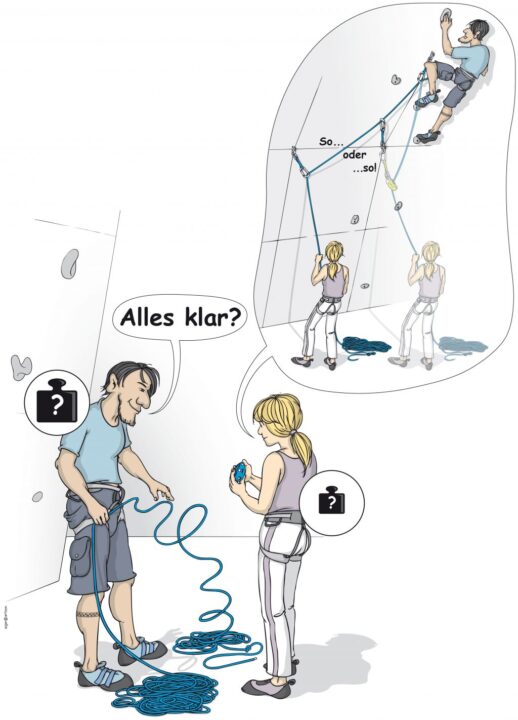
1. Team-Setup at the Beginning!
- Clarify weight difference, take appropriate measures
- Consider safety skills and how you feel on the day
- Agree on communication rules
- Check climbing equipment
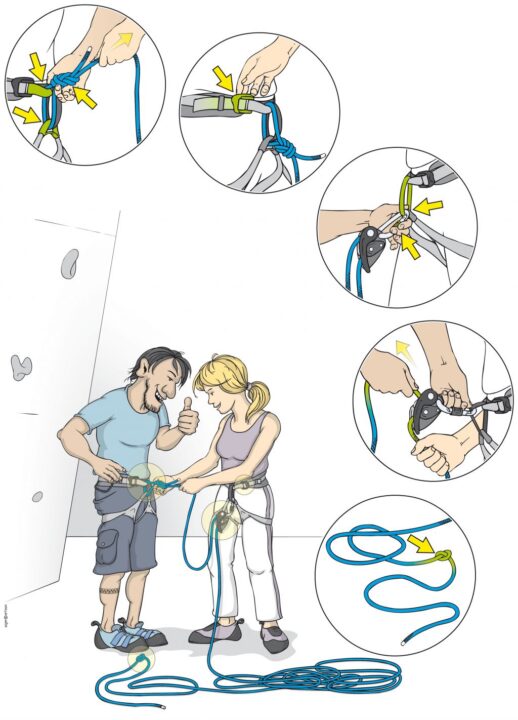
2. Partner check before every start!
Mutual check with eyes and hands:
- Tie-in knot and tie-in point
- Belay carabiner
- Belay device and brake test
- Harness and harness fastener
- End of rope tied off
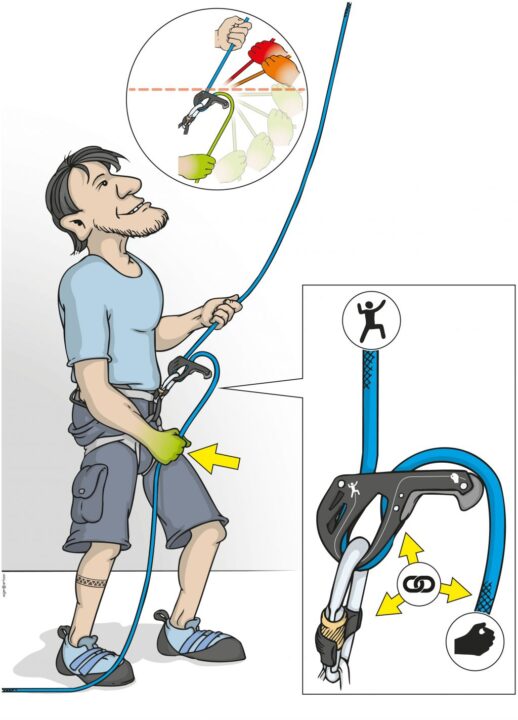
3. Belay only with equipment you are familiar with!
- Semi-automatic devices offer better security
- Brake hand principle: one hand always holds the braking side
- Note the correct position of the braking hand
- Carabiner, rope and belay device all go together
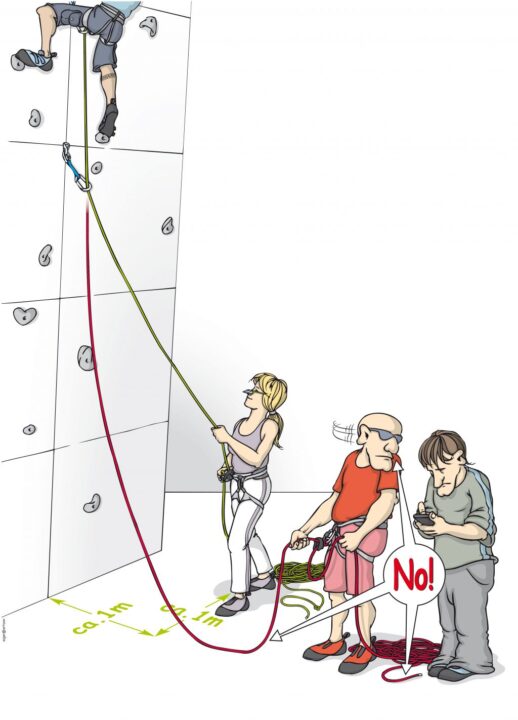
4. Full attention when belaying!
- No slack rope
- Choose the proper location near the wall
- Watch your partner
- Belay glasses help with attention
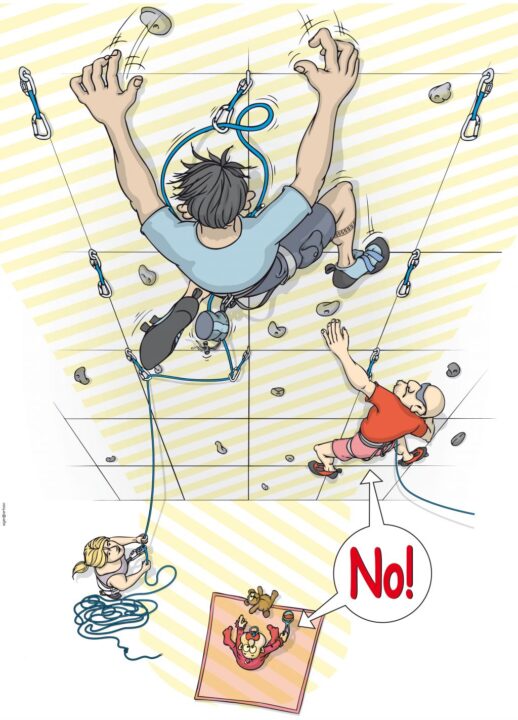
5. Keep fall space clear!
- Be generous when assessing the area for possible collisons
- On the ground stay away from the fall line of the climber
- On the route keep enough space between you and other climbers
- Be careful of possible pendulum falls
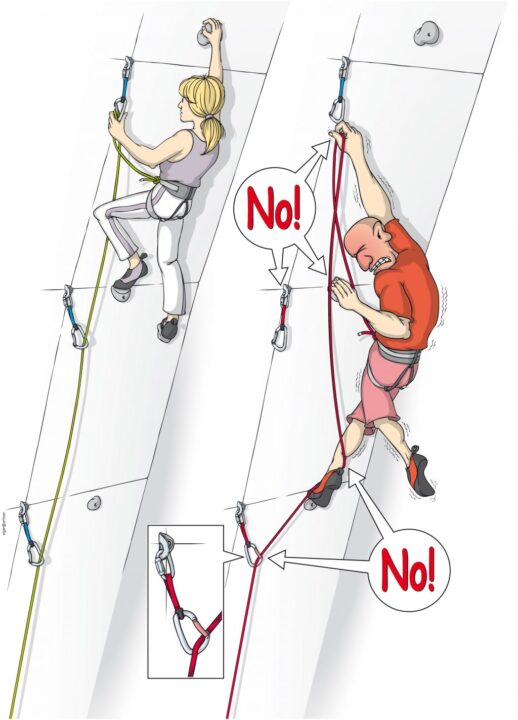
6. Clip all bolts
- Clip from a stable position
- Avoid falling while clipping - ground fall possible
- Ensure that the rope passes properly through the carabiner
- Don’t climb behind the rope
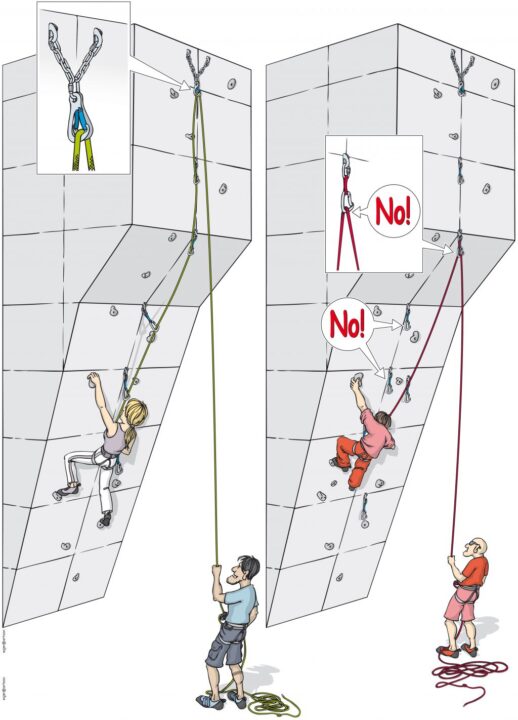
7. Top rope only from designated anchor points!
- No top-roping from a single carabiner
- Top rope on steeply overhanging routes only when the intermediate bolts have been clipped
- Make sure the correct end of the rope is in the belay device
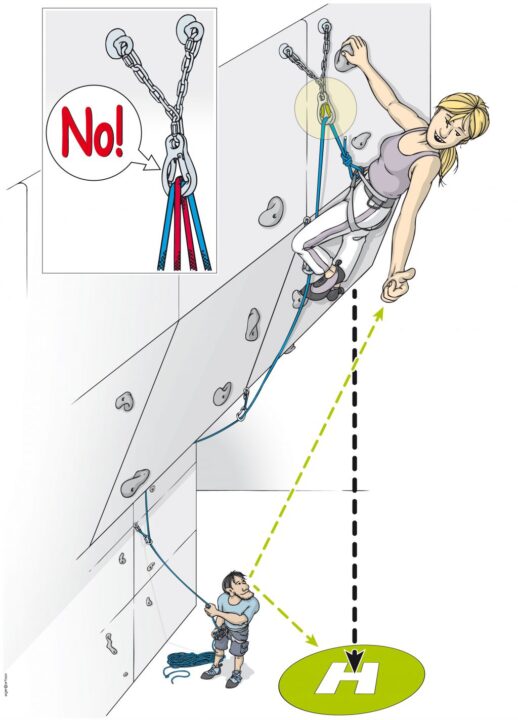
8. Be careful when lowering!
- Lower your partner slowly and steadily
- Watch out that the landing place is free
- Never put two ropes into the same carabiner
- Communicate when you reach the anchor point
Safety In
Bouldering
- Warm up: Very high physical loads occur when bouldering and jumping down. Warm up outside of danger zones to be ready for both climbing and for jumping down.
- Learn how to jump: Landing correctly when jumping off requires well-trained leg muscles and lots of body tension. Land with your legs slightly bent and roll backwards as far as possible without using your arms (risk of injury). Above all, avoid landing with straight legs.
- Get secured: Have yourself secured or spotted on very high or difficult boulders and make sure that your belay partner does not get hurt. Small children and beginners should only boulder so high that they never get out of reach of the belayer.
- Assess the risks: Adjust the risk, height and difficulty of the boulder to your own ability and avoid unnecessary falls. Small children should not boulder higher than 3 m unsecured.
- Do not sit around on bouldering mats: The bouldering mats are intended to prevent injuries from falls and must not be used for sitting or lying around. Please only sit at the edge of the mat and do not place any hard objects on the mat (water bottles, etc.)
- Keep fall space free: Before you start on a boulder problem, make sure that your fall space is free and that there are no other climbers under you. Make sure there are no objects like bottles, brushes, etc lying around on the mat. When you take a break, sit on the edge of the mats or on the benches. Do not take bottles with you to the bouldering mat, but place them on the floor in front of the mat or on the shelves.
- Keep your distance: Keep a sufficient distance from other boulderers. A leg swinging through the air can seriously injure you.
- Climb down instead of jumping off: spare your back and use the numerous "down climb" holds attached into the boulder wall instead of jumping off from high up.
- Watch out for children running around: Despite the fact that children should be supervised, children occasionally run around. Please be considerate of the little ones and make them and their supervisors aware of the dangers.
Safe Bouldering Indoor
The 5 Rules of the Alpenverein
Source: Sicher Bouldern Indoor
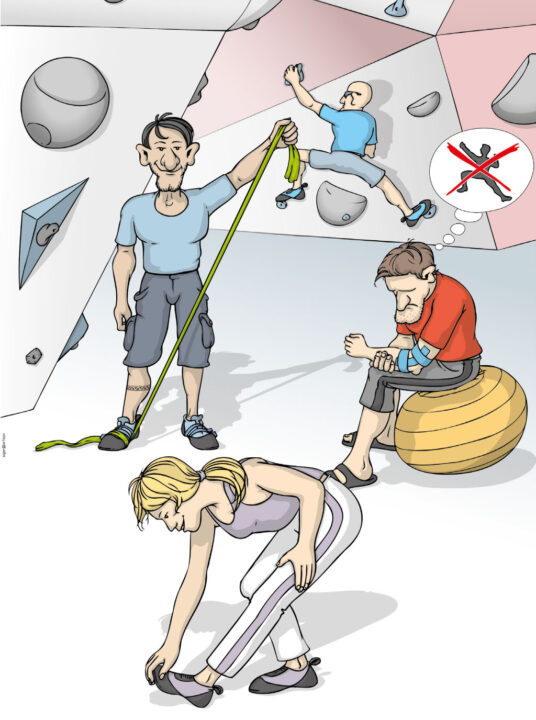
1. Warming up
- A proper warm-up protects muscles, ligaments and tendons
- Warm-up only in appropriate areas
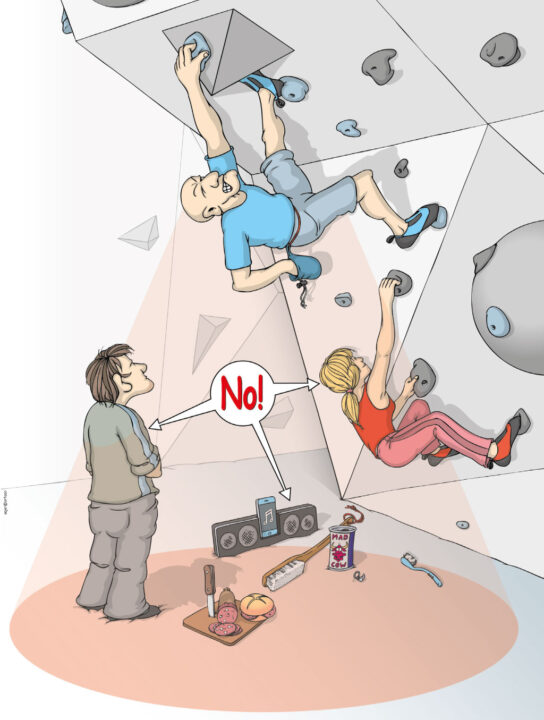
2. Keep fall areas free
- Don’t hang around under boulders
- Don’t leave objects lying around
- Don’t climb too close next to or above each other
- Overestimate the size of the landing zone
